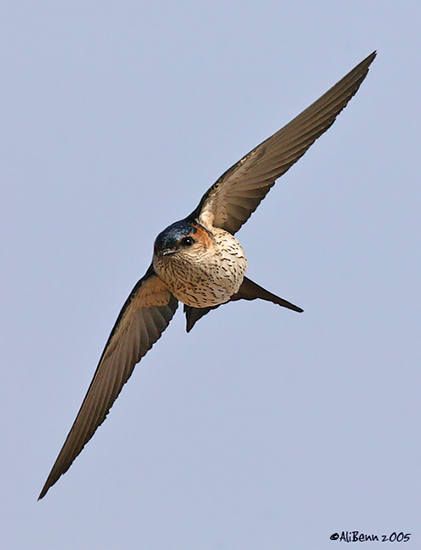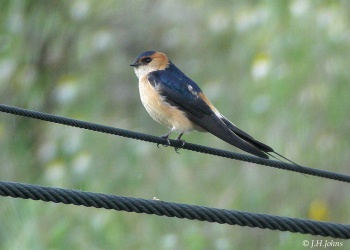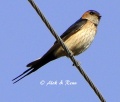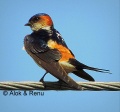- Cecropis daurica
Includes: West African Swallow
Hirundo daurica
Identification
16–17 cm (6¼-6¾ in)
Warm buff underparts that vary geographically from plain to quite strongly streaked (especially in northern China). Dark, glossy-blue upperparts, crown and back noticeably interrupted by chestnut nape and chestnut to orange-rufous rump. Upperwing and uppertail are blackish. Outer rectrices are elongated up to 3½ cm forming a deep fork. The blackish bill is short and flat with a wide gape. Eyes are dark brown. The short legs and the small, weak feet are blackish. Sexes are similar but the female has a shorter tail than the male. Juvenile is duller, browner above, paler below with less distinct streaking. Wing coverts tipped with buff.
Variations
The black vent and undertail coverts are prominent in Europe but much reduced in birds from e.g., India.
Similar Species
Lacks the dark red face and breast band with sharp contrast to pale belly of Barn Swallow but instead has more black on the rear (vent is pale in Barn Swallow). Looks more thickset in flight which also gives impression of being slower. In area of overlap, Striated Swallow must also be considered. It differs in larger size, heavier streaking and lack of a clear collar. Rufous-bellied Swallow confined to the Malay Peninsula is similar but has redder underparts and lacks obvious streaking.
Distribution
Portugal and Spain to Japan, Nepal, India and tropical Africa. At least northernmost populations are migratory, in winter ranges to Southern Africa and northern Australia.
Often occurs as vagrant north of breeding ranges, for example in Britain and Denmark.
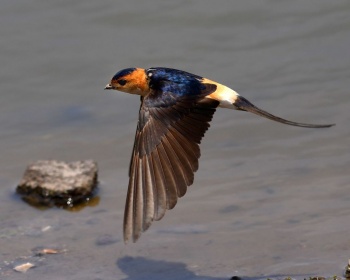
Photo © by Dennis Capewell
Lesvos, Greece, 24 May 2017
Taxonomy
Previously included in genus Hirundo
Sri Lanka Swallow was formerly included in this species.
Subspecies
Nine[1] or ten subspecies are recognised;
- C. d. daurica: Unstreaked rump. Pale buff to whitish underparts with long, fairly dark streaks.
- C. d. japonica: Indistinct streaking on rump, heavily streaked underparts and interrupted collar.
- C. d. nipalensis: Pale rufous underparts with moderate-width streaks; rump two-toned with rufous higher up and creamy-buff lower down.
- C. d. erythropygia: Buffy-white underparts with very fine streaks, rump dark chestnut.
- C. d. rufula: Whitish almost unstreaked underparts, whitish rump and complete collar.
- Iberian Peninsula to North Africa, Iran, Afghanistan and north-western India
- C. d. domicella: White or pinkish-buff underparts with little streaking.
- Senegambia to southern Sudan and extreme north-western Uganda
- C. d. kumboensis: Intermediate between C. d. emini and C. d. melanocrissus.
- Sierra Leone (Birwa Plateau) and Cameroon (Bamenda highlands)
- C. d. emini: Pale rufous underparts without streaks.
- Southeastern South Sudan and eastern Democratic Republic of the Congo south through Uganda and Kenya to Malawi and northern Zambia
- C. d. melanocrissus: Buffy below with small streaks confined to breast.
- Highlands of Ethiopia
C. d. domicella from West Africa is sometimes split as West African Swallow,
Habitat
Plains, grassland, rocky outcrops.
Behaviour
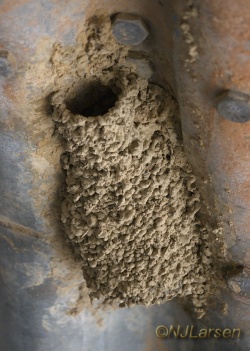
Photo © by Niels J. Larsen
Near Castro Verde, Alentejo, Portugal, 7 June 2013
Actions
They forage alone, in pairs or in small groups. Flight consists of steady gliding and rapid wingbeats. They catch flying insects by aerial pursuit, sometimes up to 100 meters or more. They also pick up insects while perched in vegetation or even on the ground.
Breeding
Monogamous. Breeds in pairs or in loose groups of less than 50 pairs sometimes clustered into colonies or dispersed. Male performs aerial display circling while calling around the female. Both adults build the nest. The flask-shaped mud nest has a tunnel entrance. Nest is lined with soft grass and feathers. It is placed on rocky ledges, buildings, under bridges and caves. Clutch size is 2-7 eggs with African birds average smaller clutches. Eggs hatch asynchronously. Older, stronger nestlings get more food and have an increased chance of survival.
Diet
Primarily insects such as flies, beetles, bugs, termites, grasshoppers and wasps. Prey items vary locally depending on the season.
Movements
Migratory in northern parts of its range, but mostly resident in the south. They form flocks of varying size after breeding with other swallow species and swifts.
Vocalisation
Contact call is a House-sparrow-like chirp tchreet and a nasal tzueeee. Alarm call is a sharp kiir. Song is a twittering warble resembles that of Barn Swallow but with lower-pitched twittering, harsher, slower, shorter and more nasal. Listen to a Red-rumped Swallow sound clip
Gallery
Click images to see larger version
Juveniles
Photo © by Shantilal Varu
Jamnagar dist, Gujarat, India, 10 July, 2022Ssp. nipalensis
Photo © by Alok Tewari
Dwarahat, Uttarakhand Himalayas, 5200 ft. above MSL, India, 11 April 2011Ssp. erythropygia
Photo © by Alok Tewari
Sultanpur, Dist. Gurgaon, Haryana, India, 19 March 2014
References
- Clements, J. F., T. S. Schulenberg, M. J. Iliff, S. M. Billerman, T. A. Fredericks, J. A. Gerbracht, D. Lepage, B. L. Sullivan, and C. L. Wood. 2021. The eBird/Clements checklist of Birds of the World: v2021. Downloaded from https://www.birds.cornell.edu/clementschecklist/download/
- BF Member observations
- Peterson, RT, G Mountfort and PAD Hollom. 1993. Collins Field Guide – Birds of Britain and Europe, 5th Revised edition. London: HarperCollins Publishers. ISBN 978-0002199001
- Birdforum Id-forum thread discussing red-rumped swallow
- Birdforum Id-forum thread discussing red-rumped swallow
- Turner, A. & Kirwan, G.M. (2019). Red-rumped Swallow (Cecropis daurica). In: del Hoyo, J., Elliott, A., Sargatal, J., Christie, D.A. & de Juana, E. (eds.). Handbook of the Birds of the World Alive. Lynx Edicions, Barcelona. (retrieved from https://www.hbw.com/node/57753 on 25 January 2019).
Recommended Citation
- BirdForum Opus contributors. (2025) Red-rumped Swallow. In: BirdForum, the forum for wild birds and birding. Retrieved 30 April 2025 from https://www.birdforum.net/opus/Red-rumped_Swallow
External Links
Search the Gallery using the scientific name:
Search the Gallery using the common name:
GSearch checked for 2020 platform.




